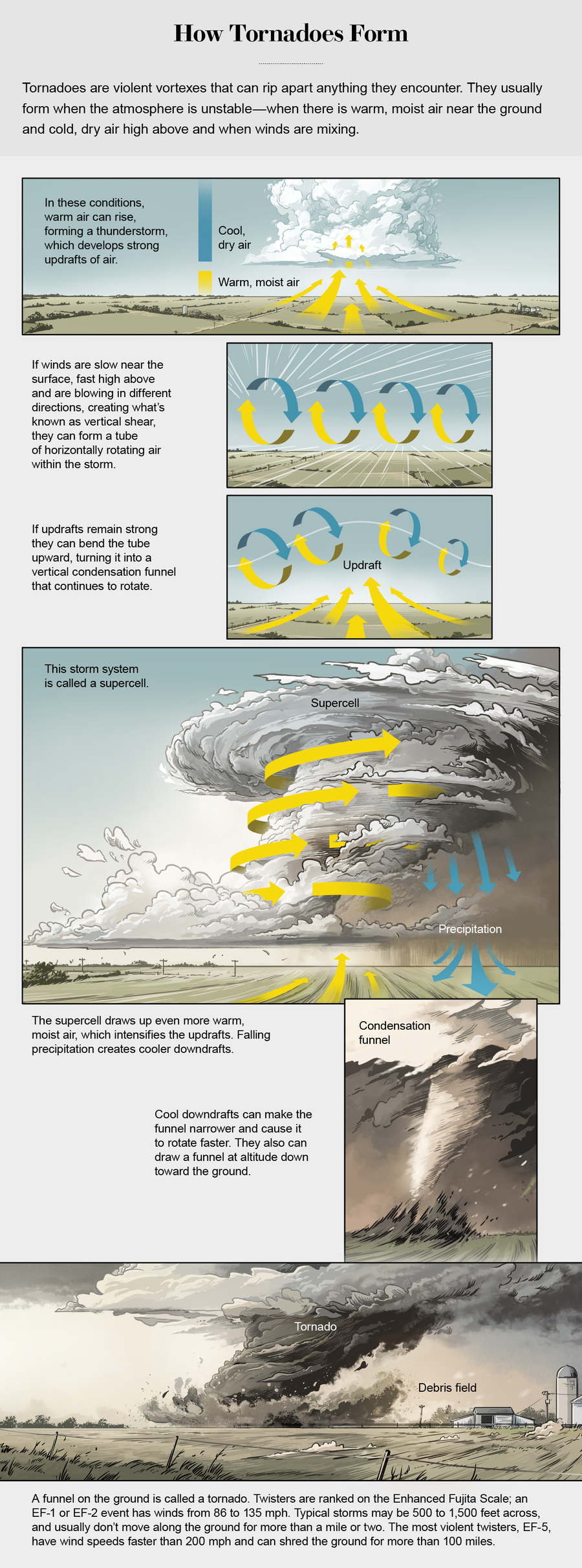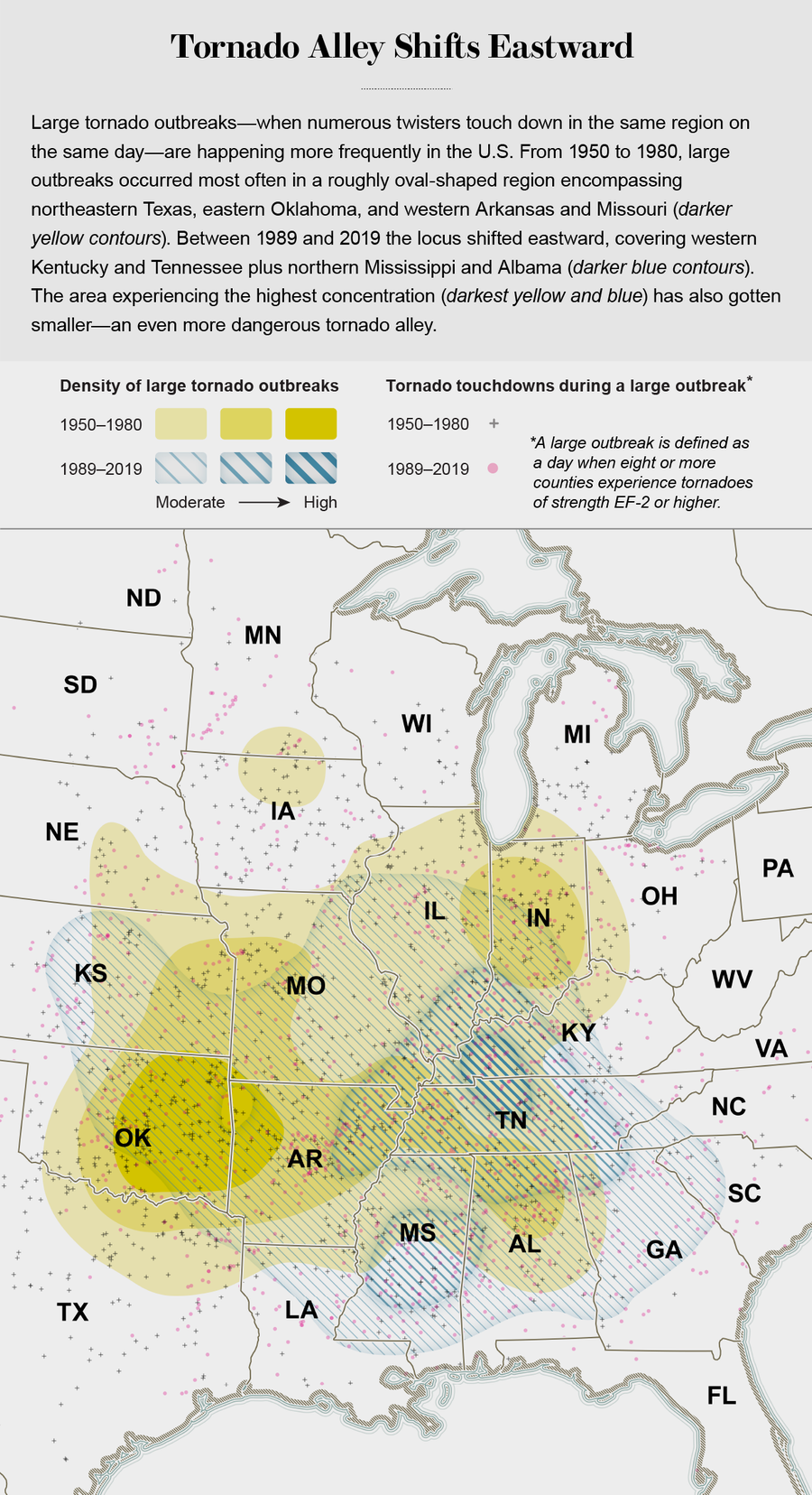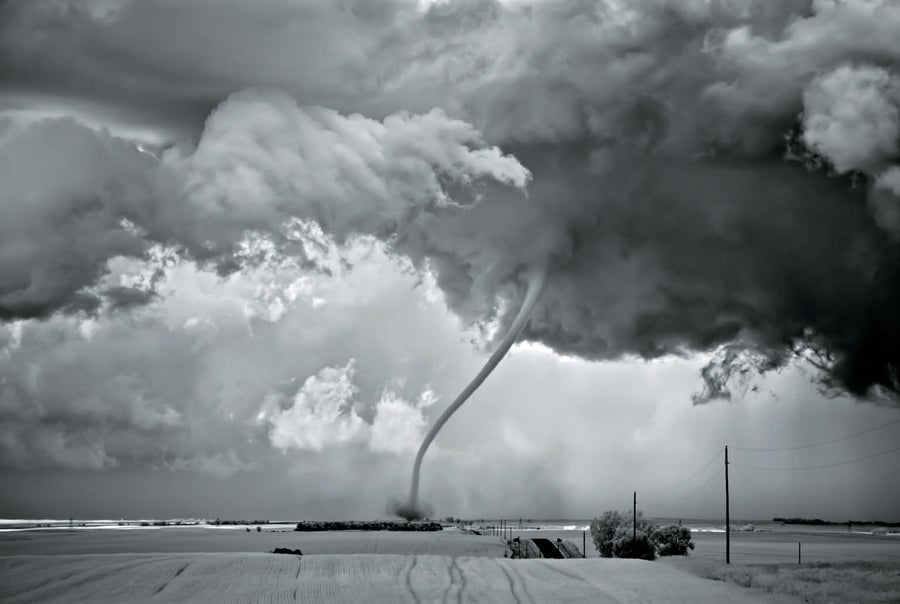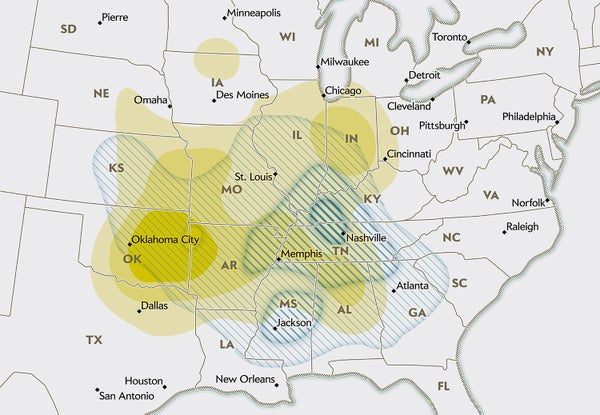Roughly 1,200 tornadoes strike the U.S. during an average year. They're prevalent in the U.S.—far more so than anywhere else in the world—because its geography sets up the perfect conditions, especially in spring and summer. Westerly winds from the Pacific Ocean drop their moisture when they push up over the Rocky Mountains, becoming high, dry and cool as they move farther east. Similar winds may descend from Canada. Meanwhile low, warm, humid air streams northward from the Gulf of Mexico. Flat terrain along these paths allows the winds to move relatively uninterrupted, at contrasting altitudes, until they run into one another. The angles at which they collide tend to create unstable air and wind shear, two big factors that favor tornado formation. Although somewhat similar air masses do clash in other places, such as Uruguay and Bangladesh, the forces are much more powerful over the U.S. Canada ranks second worldwide with 100 twisters a year.

Credit: Matthew Twombly
Although tornadoes touch down in many places across the eastern half of the country, from the 1950s through the 1990s they struck most often in Tornado Alley, an oval area centered on northeastern Texas and south-central Oklahoma. More recently, that focus has shifted eastward by 400 to 500 miles. In the past decade or so tornadoes have become prevalent in eastern Missouri and Arkansas, western Tennessee and Kentucky, and northern Mississippi and Alabama—a new region of concentrated storms.
On supporting science journalism
If you're enjoying this article, consider supporting our award-winning journalism by subscribing. By purchasing a subscription you are helping to ensure the future of impactful stories about the discoveries and ideas shaping our world today.

Credit: Daniel P. Huffman (map); Source: “Examining the Changes in the Spatial Manifestation and the Rate of Arrival of Large Tornado Outbreaks,” by Niloufar Nouri and Naresh Devineni, in Environmental Research Communications, Vol. 4; February 2022 (data)
Tornado activity in early 2023 epitomized the trend. A violent twister with wind speeds of 170 miles per hour struck Rolling Fork, Miss., on March 24, killing at least 26 people. A week later storms in the new tornado alley killed more than 30 people, and another group on April 4 damaged more than 80 structures in Bollinger County, Missouri. Those events happened in just the run-up to peak season in April and May.
Data gathered in the past two years show that in addition to solo storms, large tornado outbreaks—multiple twisters spawned by a single weather system—are shifting even more definitively to the east. The swarms are clustering in a tighter geographical area than in the old Tornado Alley, too. And outbreaks may be getting fiercer and more frequent. “It looks as if we may be having fewer days in the U.S. with just one tornado and more days when there are multiple tornadoes,” says Naresh Devineni, an associate professor at City University of New York, who co-led a 2021 geographical analysis of large tornado outbreaks.
Why is this shift happening now? Most often tornadoes are created by a supercell—a strong thunderstorm with a rotating updraft of air. Supercells tend to form when warm, humid, low-level air interacts with cool, dry, upper-level air, and climate change is generating warmer, moister air. Tornadoes also are more likely to develop when the local atmosphere is unstable, “and warming increases instability,” says Zuohao Cao, a tornado expert at Environment and Climate Change Canada, who co-led a recent study on storm touchdown locations. Climate change is warming the Gulf of Mexico as well, which can send generous amounts of water vapor into the southeastern U.S.
Research suggests that the so-called dry line is also shifting eastward. The imaginary line runs north from the U.S.-Mexico border up to Canada, dividing the wetter eastern U.S. from the drier western U.S. (To the east, thirsty crops such as corn predominate; to the west, drought-tolerant wheat prevails.) The line, which for centuries has fallen roughly along the 100th meridian, has moved east by about 140 miles since the late 1800s. The dry line “can be a boundary for convection—the rising of warm air and sinking of colder air that can fuel storms,” wrote Ernest Agee, professor emeritus of atmospheric science at Purdue University, in the Conversation in 2022.

A twister formed by a supercell nears its final stage, known as a “rope out” when it takes this shape. Credit: Mitch Dobrowner
Climate change may extend the typical tornado season as well. Milder winters mean the unstable air masses that can create supercells may become more likely in March or even earlier in the southeastern U.S.
Tornado Alley moving eastward is more than a meteorological curiosity. The shift is serious: Tornado shelters are common in Texas and Oklahoma but less so elsewhere. The Southeast is more densely populated, and mobile homes, which fare poorly in windstorms, are much more common. Tornadoes in the Southeast also occur at night more often than they do farther west, in part because winds can bring ample moisture from the Gulf after dark. Studies show that tornadoes that strike at night are 2.5 times more likely to cause fatalities.
Local and state governments in the new bull's-eye region might want to improve community shelters and warning systems, strengthen building codes, better equip emergency responders, and educate residents about what to do—and not to do—if a tornado is headed their way.

